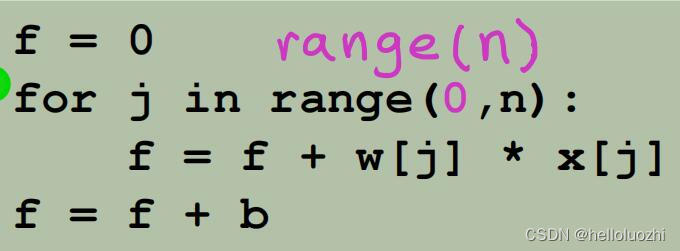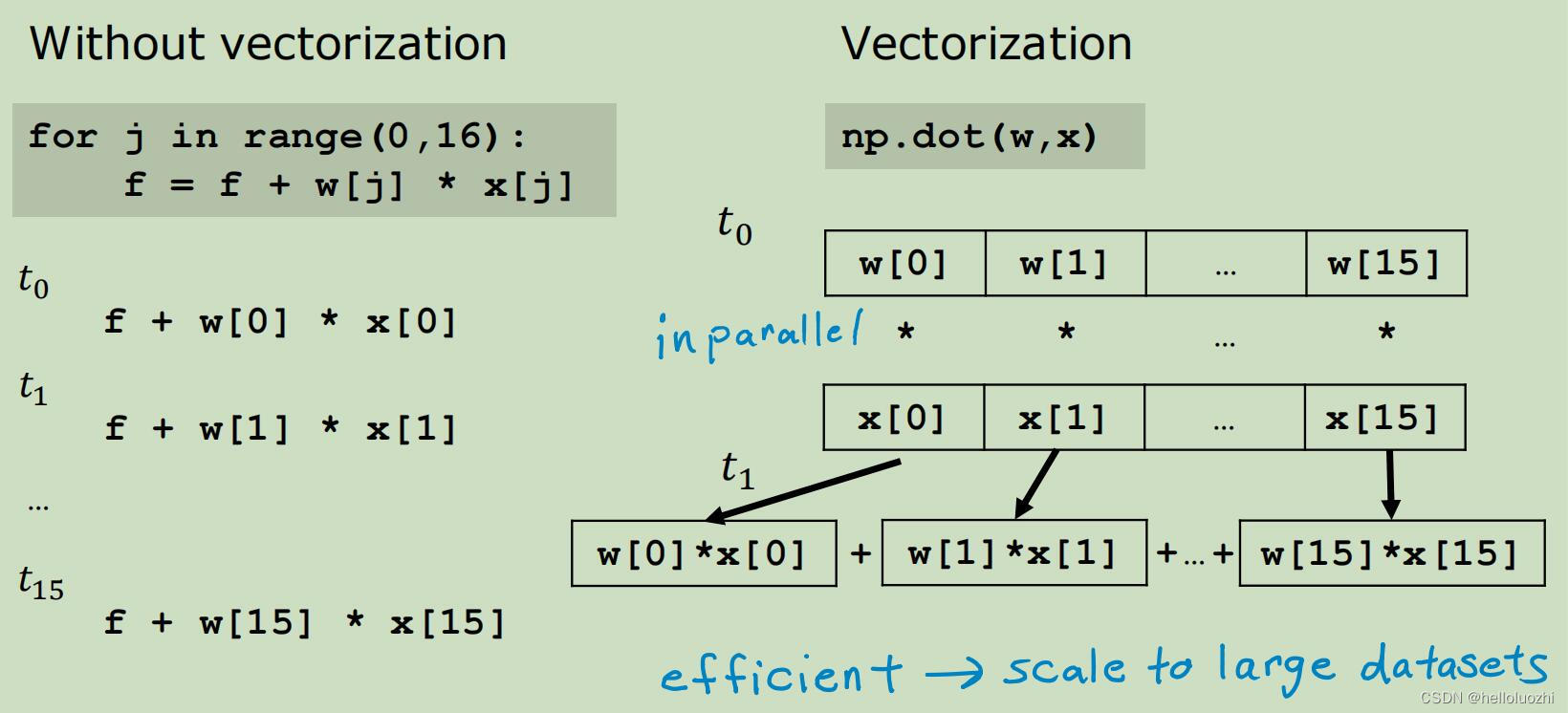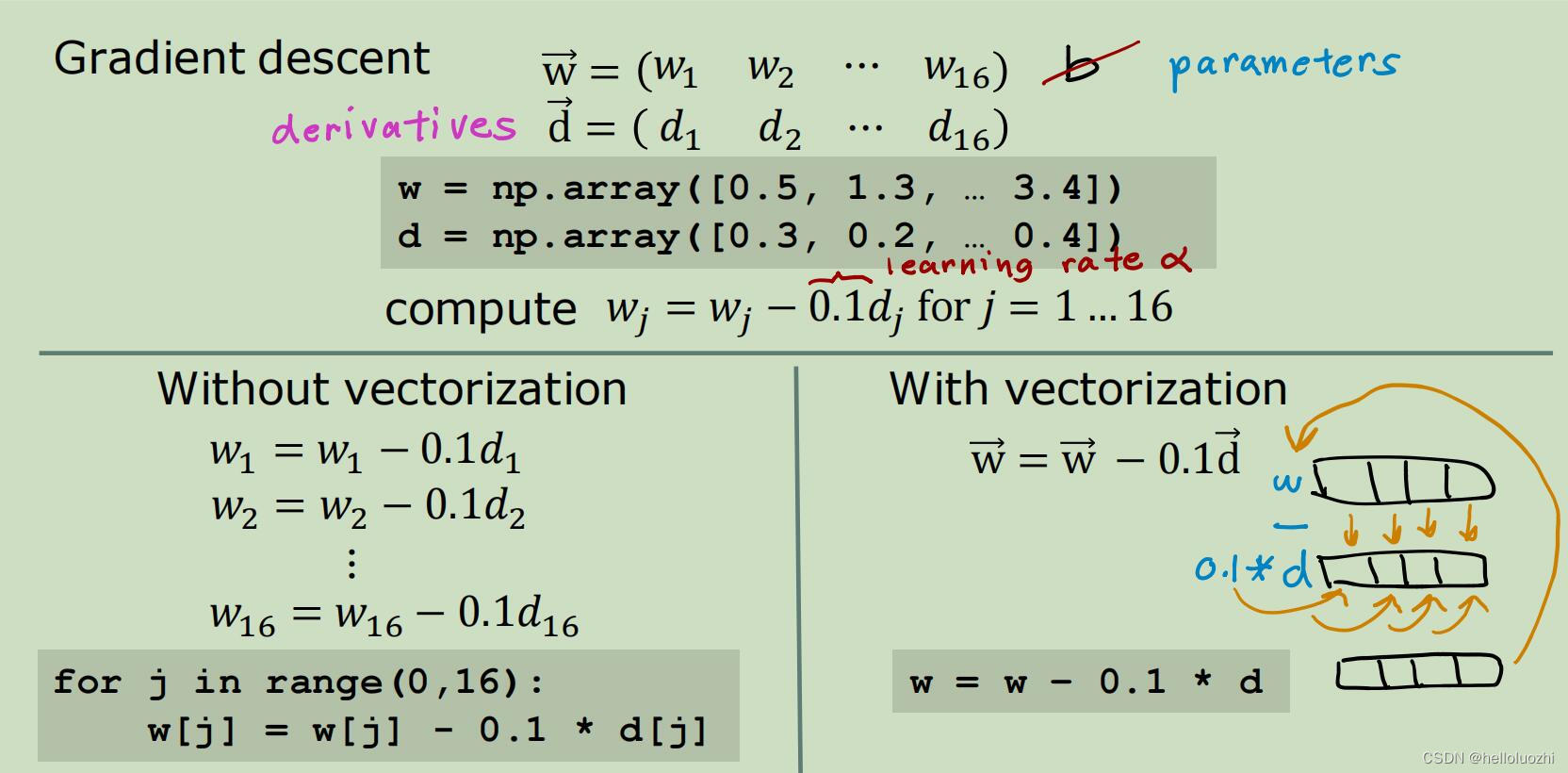文章目录
- 1 多重特征Multiple Features
-
- 1.1 向量化Vectorization
- 1.2 代码与效率对比
-
- 1.2.1 向量的创建Vector Creation
- 1.2.2 向量的操作Operations on Vectors
-
- 1.2.2.1 如何索引Indexing
- 1.2.2.2 切片Slicing
- 1.2.2.3 对整个向量操作
- 1.2.2.4 向量之间操作
- 1.2.2.5 标量与向量的操作
- 1.2.2.6 向量点积***
- 1.2.2.7 向量的shape
- 1.2.3 矩阵Matrix的代码表示
-
- 1.2.3.1 创建矩阵Matrix creation
- 1.2.3.2 矩阵索引
- 1.2.3.2 矩阵切片
- 1.3 代码:多特征线性回归Multiple Variable Linear Regression
-
- 1.3.1 房价模型
- 1.3.2 线性回归模型
- 1.3.3 计算cost
- 1.3.4 计算梯度Compute gradient
- 1.3.5 梯度下降Gradient Descent
- 2 梯度下降Gradient descent in practice
-
- 2.1 特征缩放与学习率 Feature scaling and Learning Rate
-
- 2.1.1 学习率 Learning Rate
- 2.1.2 特征缩放Feature scaling
- 2.2 特征工程与多项式回归 Feature Engineering and Polynomial Regression
-
- 2.2.1 多项式回归 Polynomial Regression
- 2.2.2 特征工程Feature Engineering
- 2.2.3 特征缩放 Scaling features
- 2.3 Linear Regression using Scikit-Learn
- 2.4 在线练习(常练常新)

1 多重特征Multiple Features
房价不只size一个特征,还可能有卧室数,地板数,房子年龄.例如
x^(i) = [size, bedrooms, floors, age of home]
可以再加一个下标j表示第几个元素.现在
Subscript[x, j]^(i)表示第i个样例的第j个特征的值.
现在多个特征的线性回归模型可写为

这里w也是向量,b是标量bias.
1.1 向量化Vectorization
我们需要在代码中简洁表示向量点乘,借助NumPy
我们可以把特征feature向量和权重weight向量写为

现在要怎么表达w点积x呢?
用

和

不好,因为代码运行更慢.
直接用np.dao(w,x)

1.2 代码与效率对比
Vectorization后在电脑中计算时并行计算点乘和梯度下降,时间复杂度O(1),比没有Vectorization的O(n)更快.
- 导入
numpy和time(看花费的时间)
import numpy as np
import time
1.2.1 向量的创建Vector Creation
# NumPy routines which allocate memory and fill arrays with value
a = np.zeros(4); print(f"np.zeros(4) : a = {
a}, a shape = {
a.shape}, a data type = {
a.dtype}")
a = np.zeros((4,)); print(f"np.zeros(4,) : a = {
a}, a shape = {
a.shape}, a data type = {
a.dtype}")
a = np.random.random_sample(4); print(f"np.random.random_sample(4): a = {
a}, a shape = {
a.shape}, a data type = {
a.dtype}")
np.zeros(4) : a = [0. 0. 0. 0.], a shape = (4,), a data type = float64
np.zeros(4,) : a = [0. 0. 0. 0.], a shape = (4,), a data type = float64
np.random.random_sample(4): a = [0.43105022 0.79710395 0.16488279 0.73185609], a shape = (4,), a data type = float64
zeros元素是零,random是随机
# NumPy routines which allocate memory and fill arrays with value but do not accept shape as input argument
a = np.arange(4.); print(f"np.arange(4.): a = {
a}, a shape = {
a.shape}, a data type = {
a.dtype}")
a = np.random.rand(4); print(f"np.random.rand(4): a = {
a}, a shape = {
a.shape}, a data type = {
a.dtype}")
np.arange(4.): a = [0. 1. 2. 3.], a shape = (4,), a data type = float64
np.random.rand(4): a = [0.95584264 0.41866986 0.19089539 0.32726125], a shape = (4,), a data type = float64
arange是递增.
# NumPy routines which allocate memory and fill with user specified values
a = np.array([5,4,3,2]); print(f"np.array([5,4,3,2]): a = {
a}, a shape = {
a.shape}, a data type = {
a.dtype}")
a = np.array([5.,4,3,2]); print(f"np.array([5.,4,3,2]): a = {
a}, a shape = {
a.shape}, a data type = {
a.dtype}")
np.array([5,4,3,2]): a = [5 4 3 2], a shape = (4,), a data type = int64
np.array([5.,4,3,2]): a = [5. 4. 3. 2.], a shape = (4,), a data type = float64
或直接指定.
1.2.2 向量的操作Operations on Vectors
1.2.2.1 如何索引Indexing
和C语言一样,索引是从零开始
#vector indexing operations on 1-D vectors
a = np.arange(10)
print(a)
#access an element
print(f"a[2].shape: {
a[2].shape} a[2] = {
a[2]}, Accessing an element returns a scalar")
# access the last element, negative indexes count from the end
print(f"a[-1] = {
a[-1]}")
#indexs must be within the range of the vector or they will produce and error
try:
c = a[10]
except Exception as e:
print("The error message you'll see is:")
print(e)
[0 1 2 3 4 5 6 7 8 9]
a[2].shape: () a[2] = 2, Accessing an element returns a scalar
a[-1] = 9
The error message you'll see is:
index 10 is out of bounds for axis 0 with size 10
1.2.2.2 切片Slicing
切片使用一组三个值 (start:stop:step) 创建一个索引数组。
各种切片:
#vector slicing operations
a = np.arange(10)
print(f"a = {
a}")
#access 5 consecutive elements (start:stop:step)
c = a[2:7:1]; print("a[2:7:1] = ", c)
# access 3 elements separated by two
c = a[2:7:2]; print("a[2:7:2] = ", c)
# access all elements index 3 and above
c = a[3:]; print("a[3:] = ", c)
# access all elements below index 3
c = a[:3]; print("a[:3] = ", c)
# access all elements
c = a[:]; print("a[:] = ", c)
a = [0 1 2 3 4 5 6 7 8 9]
a[2:7:1] = [2 3 4 5 6]
a[2:7:2] = [2 4 6]
a[3:] = [3 4 5 6 7 8 9]
a[:3] = [0 1 2]
a[:] = [0 1 2 3 4 5 6 7 8 9]
1.2.2.3 对整个向量操作
a = np.array([1,2,3,4])
print(f"a : {
a}")
# negate elements of a
b = -a
print(f"b = -a : {
b}")
# sum all elements of a, returns a scalar
b = np.sum(a)
print(f"b = np.sum(a) : {
b}")
b = np.mean(a)
print(f"b = np.mean(a): {
b}")
b = a**2
print(f"b = a**2 : {
b}")
a : [1 2 3 4]
b = -a : [-1 -2 -3 -4]
b = np.sum(a) : 10
b = np.mean(a): 2.5
b = a**2 : [ 1 4 9 16]
1.2.2.4 向量之间操作
向量加法
a = np.array([ 1, 2, 3, 4])
b = np.array([-1,-2, 3, 4])
print(f"Binary operators work element wise: {
a + b}")
Binary operators work element wise: [0 0 6 8]
加法需要向量一样长
#try a mismatched vector operation
c = np.array([1, 2])
try:
d = a + c
except Exception as e:
print("The error message you'll see is:")
print(e)
The error message you'll see is:
operands could not be broadcast together with shapes (4,) (2,)
1.2.2.5 标量与向量的操作
乘法
a = np.array([1, 2, 3, 4])
# multiply a by a scalar
b = 5 * a
print(f"b = 5 * a : {
b}")
b = 5 * a : [ 5 10 15 20]
1.2.2.6 向量点积***
虽然可以写函数用循环实现
定义
def my_dot(a, b):
"""
Compute the dot product of two vectors
Args:
a (ndarray (n,)): input vector
b (ndarray (n,)): input vector with same dimension as a
Returns:
x (scalar):
"""
x=0
for i in range(a.shape[0]):
x = x + a[i] * b[i]
return x
实现
# test 1-D
a = np.array([1, 2, 3, 4])
b = np.array([-1, 4, 3, 2])
print(f"my_dot(a, b) = {
my_dot(a, b)}")
my_dot(a, b) = 24
但这个太慢,我们用
# test 1-D
a = np.array([1, 2, 3, 4])
b = np.array([-1, 4, 3, 2])
c = np.dot(a, b)
print(f"NumPy 1-D np.dot(a, b) = {
c}, np.dot(a, b).shape = {
c.shape} ")
c = np.dot(b, a)
print(f"NumPy 1-D np.dot(b, a) = {
c}, np.dot(a, b).shape = {
c.shape} ")
NumPy 1-D np.dot(a, b) = 24, np.dot(a, b).shape = ()
NumPy 1-D np.dot(b, a) = 24, np.dot(a, b).shape = ()
np.dot(a, b).shape = () 的括号为空表示是标量
循环更慢的代码证明,对长度一千万的向量:
np.random.seed(1)
a = np.random.rand(10000000) # very large arrays
b = np.random.rand(10000000)
tic = time.time() # capture start time
c = np.dot(a, b)
toc = time.time() # capture end time
print(f"np.dot(a, b) = {
c:.4f}")
print(f"Vectorized version duration: {
1000*(toc-tic):.4f} ms ")
tic = time.time() # capture start time
c = my_dot(a,b)
toc = time.time() # capture end time
print(f"my_dot(a, b) = {
c:.4f}")
print(f"loop version duration: {
1000*(toc-tic):.4f} ms ")
del(a);del(b) #remove these big arrays from memory
np.dot(a, b) = 2501072.5817
Vectorized version duration: 195.9784 ms
my_dot(a, b) = 2501072.5817
loop version duration: 9432.0059 ms
np.dot用时0.2秒,循环用时9秒!,不同电脑不一样,用时和硬件有关,
np.dot复杂度O(1),循环复杂度O(n)
梯度同理

- NumPy 更好地利用了底层硬件中可用的
数据并行性。 GPU 和现代 CPU 实现了单指令多数据 (SIMD) 管道,允许并行发出多个操作。 这在数据集通常非常大的机器学习中至关重要。
1.2.2.7 向量的shape
shape()中有几个数就是几维张量,0个是标量,1个是向量,2个是矩阵,n个是n维张量.数的值则代表长度.
# show common Course 1 example
X = np.array([[1],[2],[3]最后
以上就是丰富宝贝最近收集整理的关于线性回归(多重特征)1 多重特征Multiple Features2 梯度下降Gradient descent in practice的全部内容,更多相关线性回归(多重特征)1内容请搜索靠谱客的其他文章。








发表评论 取消回复